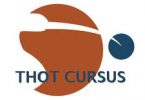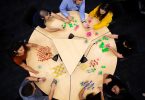Dans Campus Technology, un article de David Raths me fait découvrir le « Garage » de l’Académie Iovine and Young pour les arts, la technologie et le secteur de l’innovation à la Southern California University (14 000 pieds carrés) et la « SciBox » du Harvard University Science Center (2500 pieds carrés).
“According to HILT director Erin Driver-Linn, improving learning spaces surfaced as the most important issue when she discussed priorities for enhancing the quality of instruction at Harvard with administrators and support staff from around the University… […] If students get the idea that they are not allowed to alter the original setups of a room, they may not behave as comfortably as they would otherwise.” (Zhang, 2015, nos emphases)
Dans les deux cas, il s’agit donc d’espaces qu’enseignants et étudiants peuvent configurer selon leurs besoins. Pour le « Garage », c’était prévu dès la conception de ce nouvel espace. Le lieu inclut des ateliers de prototypage (fablab), de puissants ordinateurs avec des logiciels de création, une salle de (télé)conférence, deux salles de classe – dont une avec des poufs de type “beanbag” – ainsi qu’une cuisinette et un salon :
« “We knew we didn’t want a classroom with four walls or a lecturer in front,” [Susan Metros, doyenne associée] said. “We knew we wanted to have students be in a classroom where if the faculty member posed a question or challenge, the students could go and make something and bring it back to class, and not have to wait until the next week. Rapid iteration was paramount in terms of creative problem-solving and design thinking. From the beginning we knew the space had to be flexible, so that students could learn, make things and collaborate, and it had to be a place where creativity could evolve. Our dean calls it ‘accidental collisions.'” » (Metros, citée dans Raths, 2016)
Dans le cas de la SciBox, les enseignants de physique Franklin et McCarty se sont aperçu que les espaces vierges et configurables de type “boîte noire” (black box) étaient rares à Harvard. Ils avaient la volonté de créer cet espace imparfait/ pas fini, un espace mi-classe et mi-laboratoire, que les étudiants pourraient désorganiser (mess it up). Cela semble un aspect important du “learning by doing“. Tout devait donc être sur roulettes, les chaises et les tables, les tableaux, même l’écran géant. C’est désormais un espace qui sert aussi pour des ateliers, des classes d’été et des pratiques de théâtre.
“…According to them, the space itself actually prevents instructors from attempting a traditional lecture format. Students quickly became familiar with the most appropriate set-up formation for specific activities, and can rearrange the furniture on a moment’s notice to best suit their needs. […]
In addition to the lab and the classroom, the space also features an adjacent workshop where students can construct projects, and “the beach”—a comfortable sitting area where students can remove themselves from their projects to think and reflect. “So often when you are doing science, you need to remove yourself,” Franklin emphasized.” (HILT, 2013)
Ce besoin d’espace de repos/ de réflexion a aussi été pris en compte pour le Garage.
« “It is surprising that universities think that students should go to a class for 50 minutes and then walk out and have no spaces that they can call their own,” she said. “They don’t have a space to go in the evenings and on weekends to really think about and critically solve problems. The Garage has become that space.” » (Metros, citée dans Raths, 2016)
D’ailleurs les étudiants voulaient y être 24 h sur 24 h, ce qui n’a pas été sans causer de problème.
Sources:
Harvard Initiative for Learning and Teaching (HILT), « SciBox 1.0: An innovative, experimental learning space inspiring creative approaches to teaching », Harvard University, 2013
Harvard University, « HILT 47 Logan McCarty and Melissa Franklin » (vidéo), YouTube, 22 mars 2013 (3 min 47)
Raths, David, « Designing Learning Spaces for Innovation », Campus Technology, 8 juin 2016
Steinberg Architects, « University of Southern California, Iovine and Young Academy », 2014
Zhang, Zara, « Space Matters », Harvard Magazine, 12 juin 2015





